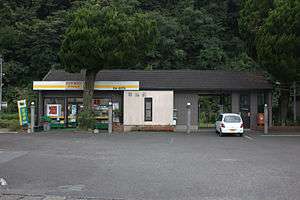Asaji Station
Asaji Station 朝地駅 | |
|---|---|
 Asaji Station in 2009 | |
| Location | Japan |
| Coordinates | 33°00′16″N 131°25′56″E / 33.00444°N 131.43222°ECoordinates: 33°00′16″N 131°25′56″E / 33.00444°N 131.43222°E |
| Operated by |
|
| Line(s) | ■ Hōhi Main Line |
| Distance | 93.9 km from Kumamoto |
| Platforms | 1 side platform |
| Tracks | 1 |
| Construction | |
| Structure type | At grade |
| Other information | |
| Status | Unstaffed |
| Website | Official website |
| History | |
| Opened | 20 December 1923 |
| Rebuilt | 1993 |
| Traffic | |
| Passengers (FY2015) | 89 daily |
| Location | |
 Asaji Station Location within Japan | |
Asaji Station (朝地駅 Asaji-eki) is a railway station in Bungo-ono City, Ōita Prefecture, Japan. It is operated by JR Kyushu and is on the Hōhi Main Line.[1][2]
Lines
The station is served by the Hōhi Main Line and is located 93.9 km from the starting point of the line at Kumamoto.[3]
Layout
The station consists of a side platform serving a single track. The station building is a modern structure but built in traditional Japanese style with a tiled roof. It houses a waiting room, a ticket booth (unstaffed) and the local tourism information centre.[3][2]
Adjacent stations
| « | Service | » | ||
|---|---|---|---|---|
| Hōhi Main Line | ||||
| Bungo-Taketa | Local | Ogata | ||
History
Japanese Government Railways (JGR) had opened the Inukai Light Rail Line (犬飼軽便線) (later Inukai Line) from Ōita to Nakahanda on 1 April 1914. The track was extended westwards in phases, with this station opening as the new western terminus on 20 December 1923. Asaji became a through-station on 15 October 1924 when the line was extended to Bungo-Taketa. By 1928, the track had been extended further west and had linked up with the Miyagi Line (宮地線) reaching eastwards from Kumamoto. On 2 December 1928, the entire track from Kumamoto through Asaji to Ōita was designated as the Hōhi Main Line. With the privatization of Japanese National Railways (JNR), the successor of JGR, on 1 April 1987, the station came under the control of JR Kyushu.[4][5]
The station became unstaffed in 1983. A new station building was completed in 1993.[6]
On 17 September 2017, Typhoon Talim (Typhoon 18) damaged the Hōhi Main Line at several locations. Services between Aso and Nakahanda, including Asaji, were suspended and replaced by bus services. Rail service from Aso through Asaji to Miemachi was restored by 22 September 2017[7] Normal rail services between Aso and Ōita were restored by 2 October 2017.[8]
Passenger statistics
In fiscal 2015, there were a total of 32,490 boarding passengers, giving a daily average of 89 passengers.[9]
See also
References
- ↑ "JR Kyushu Route Map" (PDF). JR Kyushu. Retrieved 23 February 2018.
- 1 2 "朝地" [Asaji]. hacchi-no-he.net. Retrieved 16 April 2018.
- 1 2 Kawashima, Ryōzō (2013). 図説: 日本の鉄道 四国・九州ライン 全線・全駅・全配線・第6巻 熊本 大分 エリア [Japan Railways Illustrated. Shikoku and Kyushu. All lines, all stations, all track layouts. Volume 6 Kumamoto Ōita Area] (in Japanese). Kodansha. p. 39, 79. ISBN 9784062951654.
- ↑ Ishino, Tetsu et al. (eds.) (1998). 停車場変遷大事典 国鉄・JR編 [Station Transition Directory - JNR/JR] (in Japanese). I. Tokyo: JTB Corporation. p. 228. ISBN 4533029809.
- ↑ Ishino, Tetsu et al. (eds.) (1998). 停車場変遷大事典 国鉄・JR編 [Station Transition Directory - JNR/JR] (in Japanese). II. Tokyo: JTB Corporation. p. 746. ISBN 4533029809.
- ↑ "朝地町の歴史" [History of Asaji Town]. Asaji Town official website. 8 December 2014. Retrieved 16 April 2018.
- ↑ "豊肥本線の運休区間が縮小…阿蘇~三重町間再開" [Zone of suspended services on Hōhi Main Line reduced. Aso to Miemachi reopens]. Response.jp. 22 September 2017. Archived from the original on 2 October 2017. Retrieved 15 April 2018.
- ↑ "10 月2日(月)からの日豊本線・豊肥本線の運転計画について(お知らせ)" [Operations plan for Nippo Main Line and Hōhi Main Line (notice)] (PDF). JR Kyushu. 29 September 2017. Archived from the original (PDF) on 30 September 2017. Retrieved 2017-10-01.
- ↑ "平成28年版 大分県統計年鑑 11 運輸および通信" [Oita Prefecture Statistics Yearbook 2016 Edition Section 11 Transportation and Comunications]. Oita Prefectural Government website. Retrieved 8 April 2018. See table 128 Transport situation by individual railway stations (JR Kyushu JR Freight).
| Wikimedia Commons has media related to Asaji Station. |
External links
- Asaji (JR Kyushu)(in Japanese)